|
|
Ganoderma Lucidum/Reishi
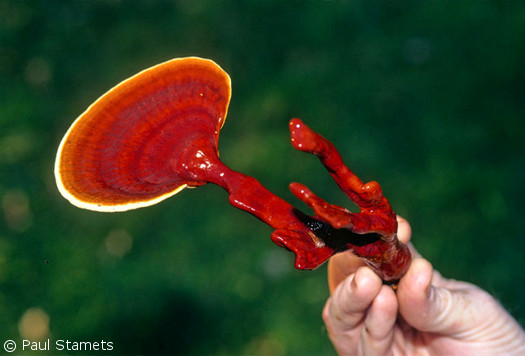 Reishi (Japanese), or Ling Zhi (霊芝, Chinese) is a spectacularly beautiful polypore mushroom.
Reishi (Japanese), or Ling Zhi (霊芝, Chinese) is a spectacularly beautiful polypore mushroom.
The iconic mushroom commonly known as Reishi (in Japanese) or Ling Zhi (靈芝 in Chinese) is probably the most respected medicinal mushroom in Asia. The earliest mention of Ling Zhi was in the era of the first emperor of China, Shinghuang of the Ch'in Dynasty 221-207 B.C.E. Once reserved for royalty to extend life and improve health, this polypore mushroom is strikingly beautiful. Deep reddish brown and saucer-shaped, often emerging from a branch-like stem, its smooth upper surface looks lacquered when wet. Because of this glossy appearance, Western mycologists called them "varnished conks" for many years (conks are mushrooms that have pores instead of gills on their undersides, such as maitake and turkey tails). While reishi mushrooms have historically been prepared as teas or infusions, other modern preparations include capsules, tinctures, and fractionated extracts of mushrooms, mycelium, and spores. Reishi is also added to chocolate bars, candies, energy drinks, and even coffee blends!
 Chinese sage in contemplation of Ling Zhi. Painted by Chen Hung-shou (1559-1652). (From Wasson, 1968)
Chinese sage in contemplation of Ling Zhi. Painted by Chen Hung-shou (1559-1652). (From Wasson, 1968)
"Reishi" is a common name for a complex of closely-allied species of the Ganoderma genus. Until recently the name reishi referred to the species Ganoderma lucidum; however, new DNA barcoding and phylogenetic techniques have revealed that this name had been inappropriately applied by taxonomists to what is in fact a group of close relatives. These new techniques are now revealing that "reishi" mushrooms once all thought to beGanoderma lucidum may have been misclassified. This misclassification is understandable, as all these morphologically-similar species naturally grow on old or dead tree trunks and all display remarkable glossy cap surfaces that can vary in color from bright red to black according to their age and environmental factors. Although these species (G. tsugae, G. oregonense, G. carnosum, and G. oerstedii, and G. resinaceum) have 98-100 percent commonality of DNA using the common "ITS genetic region," they are now considered separate species.
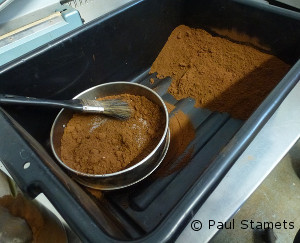
After amassing billions of reishi spores, a brush and fine mesh screen is used to remove extraneous debris.
Because of its rich history and long tradition of medicinal use, Ganoderma lucidum (in the strictest sense) is now one of the few mushroom species whose DNA has been fully sequenced (16,113 genes). Others are button mushrooms (Agaricus bisporus) with 10,438 genes and oyster mushrooms (Pleurotus ostreatus) with 12,330 genes (Joint Genome Institute). Reishi is remarkable for its diversity of genes coding for cytochrome P450 enzymes. These enzymes not only afford this species a broad arsenal for producing secondary metabolites for digesting nutrients, but may also confer benefits to human health such as enhancing the degradation of toxins and free radicals and increasing the liver's metabolic efficiency. The variety of these enzymes, among more than 400 active constituents that have been found, indicates to me that mushrooms such as reishi are like miniature pharmaceutical factories that can produce hundreds of medicinally-interactive compounds. Through trial-and-error and observable outcomes, our ancestors narrowed the field of edible mushroom candidates to just a few with remarkable, health-supporting properties. Today, reishi stands out as one the most valuable of all polypore mushrooms in nature for the benefit of our health. Many naturopaths and doctors prefer organically-grown reishi from pristine environments because they are more pure.
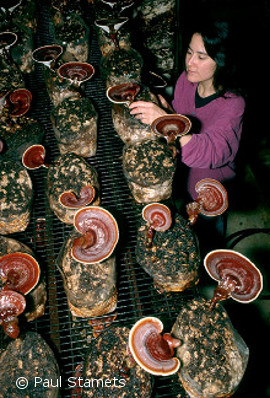 Dusty Yao admiring Red Reishi grown at Fungi Perfecti Laboratories, Kamilche Pt., Wash.
Dusty Yao admiring Red Reishi grown at Fungi Perfecti Laboratories, Kamilche Pt., Wash.
Reishi has been called the "panacea polypore," in part due to a widespread popular belief that this mushroom can help alleviate certain age-related diseases. Although many such claims are exaggerated and unsubstantiated, a number of studies have documented a range of medicinal effects.
In 2000, a group of Merck pharmaceutical scientists at the Centro de Investigaci´on B´asica, Merck Sharp & Dohme in Madrid, Spain tested the mycelial extracts of 204 species of mushrooms for their antimicrobial properties (Suay et al., 2000). The mushrooms showing the most activity were "reishi" species (G. lucidum, G. resinaceum and G. pfeifferi) of which 73 percent of the strains showed activities against the bacterium Bacillus subtilis. However, while extracts of the reishi species group all strongly inhibited Bacillus bacteria, they were curiously inactive against other disease-causing bacteria and fungi. That these Ganodermas are species specific in their antimicrobial activities suggests a unique mode of activity, a benchmark test that attracts medical researchers interested in new antibiotic drug discovery.
In my work with the U.S. Defense Department's BioShield BioDefense program, ethanol and water extracts of the living mycelium of Ganoderma resinaceum inhibited virus replication as measured by the viral yield reduction (VYR) assay of Flu A (H5N1) aka "bird flu," and Flu B viruses. Notably, a "traditional" hot water extract of the fruitbodies arising from the same mycelium demonstrated no notable antiviral activity (Stamets, 2008).
A review of the scientific literature reveals that many of the traditional medicinal claims can now be validated, especially the antioxidant and anti-inflammatory properties. However, the anti-cancer claims have yet to achieve the credibility of comparable studies on Turkey Tail (Trametes versicolor) mushrooms (see Turkey Tail post). In a recent critique of reishi studies published through 2012, the authors concluded:
Our review did not find sufficient evidence to justify the use of G. lucidum as a first-line treatment for cancer. It remains uncertain whether G. lucidum helps prolong long-term cancer survival. However, G. lucidum could be administered as an alternative adjunct to conventional treatment in consideration of its potential of enhancing tumor response and stimulating host immunity. (Jin et al. 2012)
While such conclusions presume similar sample preparations and consistent taxonomic identification from study to study, one common theme emerges. The species in the taxonomic constellation of "reishi" mushrooms consistently activate, in vitro and in vivo, human immune cells: macrophages, NK and cytotoxic T cells, on a dose-dependent basis. Moreover, in the previously-mentioned comparison of peer-reviewed studies on reishi and cancer, the authors conclude that the adjunct use of reishi may augment chemotherapeutic drugs to treat cancer and may extend their effectiveness. This is particularly important since a common concern among oncologists is that the antioxidant properties of medicinal mushrooms may interfere with chemotherapeutic drugs. Addressing this issue, Simone et al. (2007) reported:
[280 peer-reviewed studies] have consistently shown that non-prescription antioxidants and other nutrients do not interfere with cancer therapeutic modalities. In addition, nonprescription antioxidants and other nutrients enhance the killing of cancer therapeutic modalities, decrease their side effects, and protect normal tissues, and in 15 human studies, 3,738 patients actually had prolonged survival.
Although the trends are promising and reishi mushrooms exhibit a number of interesting medicinal properties, modern scientific techniques have yet to affirm its traditional "panacea polypore" status. For now we can state that reishi use is generally safe and has high antioxidant value. While we cannot yet state that reishi mushrooms extend the disease-free period of cancer patients, reishi remains as an excellent candidate for augmenting chemotherapy, according to some cancer researchers. Since funding of clinical studies is either industry-based or from grants -- few and far between -- the jury is still out on the usefulness of reishi, the "mushroom of immortality," for extending life. That said, I for one, join our ancestors in being drawn to this mushroom and regularly ingest it in many forms.
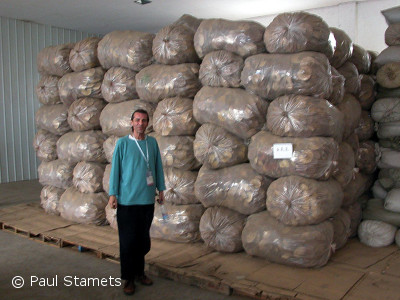
Mycologist Jean-Marc Moncalvo, presently Curator of Fungi at the Royal Ontario Museum in Toronto, was the first scientist to investigate the taxonomy of Ganoderma mushrooms using DNA sequences. Here he stands in front of more than a ton of Ling Zhi in a farm in China.
|
|
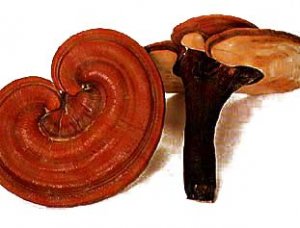 |
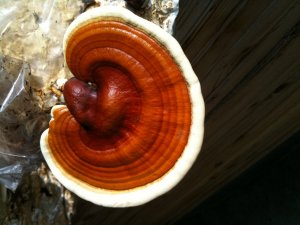 |
|
Stavinoha, W.B., 1997.
"Status of Ganoderma lucidum in United States: Ganoderma lucidum as an anti inflammatory agent
" Proceedings of the 1st International Symposium on Ganoderma lucidum in Japan.
Nov. 17-18th, 99-103. Tokyo.
Wang J. et al., 1985.
"Study of the action of Ganoderma lucidum on scavenging hydroxyl radical from plasma.
Journal of Traditional Chinese Medicine 5: 44-60.
Tao, J. and K.Y. Feng, 1990.
"Experimental and clinical studies on inhibitory effect of Ganoderma lucidum on platelet aggregation"
Journal of Tongji Medical University 10(4): 240-3.
Yang, Q.Y. & Wang, M., 1994.
"The effect of Ganoderma lucidum extract against fatigue and endurance in the absence of oxygen".
Proceedings of Contributed Symposia 59 A,B.
5th International Congress. Vancouver, Canada, August 14-21, 101-104.
Nishitoba, T., H. Saot, S. Shirasu, & S. Sakamura, 1987.
"Novel triterpenoids from the mycelial mat at the previous stage of fruiting of Ganoderma lucidum."
Agricultural & Biological Chemistry 51(2): 619-622.
Jong, S.C. and J.M. Birmingham, 1992.
"Medicinal effects of the mushroom Ganoderma.
"Adv. Appl. Microbiol. 37: 101-134.
Stavinoha, W.B., S. Weintraub, T. Opham, A. Colorado, R. Opieda, J. Slama, 1990.
Study of the anti inflammatory activity of Ganoderma lucidum.
Proceedings from the Academic/Industry Conference (AIJC), August 18-20, Sapporo, Japan.
Bao X, Fang J, Li X.
Structural characterization and immunomodulating activity of a complex glucan
from spores of Ganoderma lucidum.
Biosci Biotechnol Biochem. 2001 Nov;65(11):2384-91.
Tomoda, M., R. Gonda, Y. Kasahara, and H. Hikino, 1986.
"Antidiabetes drugs. Glycan structures of ganoderans B and D,
hypoglycemic glycans of Ganoderma lucidum fruit bodies."
Phytochemistry 25: 2817-2820.
Naeshiro, H. 1992.
"Skin lightening compositions containing Ganoderma extract"
Japan Kokai Tokkyo Koho JP 04 09, 315 (92 09, 315).
Murasugi, A., S. Tanaka, N. Komiyama, N. Iwata, K. Kino, H. Tsunoo, and S. Sakuma, 1991.
Molecular cloning of a cDNA and a gene encoding an immunomodulatory protein, Ling Zhi-8,
from a fungus, Ganoderma lucidum
Journal of Biological Chemistry Feb 5; 266(4): 2486-93.
Lieu, C.W., S.S. Lee, and S.Y. Wang, 1992.
"The effect of Ganoderma lucidum on induction of differentiation in leukemic U937 cells.
Anticancer Research Jul-Aug: 12(4): 1211-5.
Kim, B.K., H.W. Kim and E.C. Choi, 1994.
"Anti-HIV effects of Ganoderma lucidum." In Ganoderma: Systematics,
Phytopathology & Pharmacology: Proceedings of Contributed Symposium 59 A,B.
5th International Mycological Congress. Vancouver.
Chang, R. 1996.
The Central Importance of the beta-glucan receptor as the basis of immunologic bioactivity
of ganoderma polysaccharides, In Reishi,
Mizuno T, Kim BK (eds), II Yang Press, Seoul, p.177-9
Chang, R. Y. 1996.
Potential Application of Ganoderma Polysaccharides in the Immune Surveillance
and Chemoprevention of Cancer.
153-160 In: Royse, D.J. (ed). 1996.
Mushroom Biology and Mushroom Products. Proceedings of the Second International Congress.
Chen, A. W., 1997.
Topical Use of Ganoderma Mushrooms.
The Mushroom Growers Newsletter V (11), March 1997.
Chen, J & R Jiang. 1980.
A pharmacognostical study of the Chinese drug Lingzhi (Ganoderma).
Acta. Pharm. Sin. 15:244
Chen JR, 1993.
The effects of Chinese herbs on improving survival and inhibiting anti-ds DNA antibody production
in lupus mice.
Am J Chin Med 21(3-4), 257-26
Chen, K & W Zhang. 1987.
Advances on anti-aging herbal medicines in China.
Abstracts of Chinese Medicines. 1:309-330
Chen WC, 1995.
Effects of Ganoderma lucidum and krestin on cellular immunocompetence
in gamma-ray-irradiated mice.
Am J Chin Med 23(1), 71-80
Bao X, Fang J, Li X.
Structural characterization and immunomodulating activity of a complex glucan
from spores of Ganoderma lucidum.
Biosci Biotechnol Biochem. 2001 Nov;65(11):2384-91.
Chang, R. 1993.
Limitations and Potential applications of Ganoderma and related fungal polyglycans
in clinical ontology
First International Conference on Mushroom Biology and Mushroom products: 96
Chang, R. 1994.
Effective dose of ganoderma in humans. In Proc. Contributed Symposium 59A, B.
5th Intl. Mycol. Congr., Buchanan PK, Hseu RS and Moncalvo JM (eds), Taipei, p. 101-13.
Chen, A. W., 1997.
Topical Use of Ganoderma Mushrooms.
The Mushroom Growers Newsletter V (11), March 1997
Chen, J & R Jiang. 1980.
A pharmacognostical study of the Chinese drug Lingzhi (Ganoderma lucidum).
Acta. Pharm. Sin. 15:244
Chen WC, 1995.
Effects of Ganoderma lucidum and krestin on cellular immunocompetence
in gamma-ray-irradiated mice.
Am J Chin Med 23(1), 71-80
Kim RS, 1997.
Suppressive effects of Ganoderma lucidum on proliferation of peripheral blood mononuclear cells.
Mol Cells 7(1), 52-5
Chen YJ, 1997.
Effect of Cordyceps sinensis on the proliferation and differentiation of human leukemic U937 cells.
Life Sci 60(25), 2349-2359 (1997)
Fu, H. and Z. Wang. 1982.
The clinical effects of Ganoderma lucidium spore preparations in 10 cases of atrophic myotonia.
J. Trad. Chin. Med. 2:63-65.
Gao Y, Zhou S, Wen J, Huang M, Xu A.
Mechanism of the antiulcerogenic effect of Ganoderma lucidum polysaccharides
on indomethacin-induced lesions in the rat.
Life Sci. 2002 Dec 27;72(6):731-45.
Kim, B.K., H.W. Kim and E.C. Choi, 1994.
Anti-HIV effects of Ganoderma lucidum.
In : Ganoderma: Systematics, Phytopathology & Pharmacology:
Proceedings of Contributed Symposium 59 A,B.
5th International Mycological Congress. Vancouver.
Kim HS, et al. 1999.
In vitro chemopreventive effects of plant polysaccharides
(Aloe barbadensis miller, Lentinus edodes, Ganoderma lucidum and Coriolus versicolor).
Carcinogenesis.
Aug;20(8):1637-40.
Kim KC, et al. 1999.
Ganoderma lucidum extract protects DNA from strand breakage
caused by hydroxyl radical and UV irradiation.
Int J Mol Med. Sep;4(3):273-7.
Liu X, Yuan JP, Chung CK, Chen XJ.
Antitumor activity of the sporoderm-broken germinating spores of Ganoderma lucidum.
Cancer Lett. 2002 Aug 28;182(2):155-61.
Lu H, Kyo E, Uesaka T, Katoh O, Watanabe H.
Prevention of development of N,N'-dimethylhydrazine-induced colon tumors
by a water-soluble extract from cultured medium of Ganoderma lucidum (Rei-shi)
mycelia in male ICR mice.
Int J Mol Med. 2002 Feb;9(2):113-7.
Luo J, Zhao YY, Li ZB.
A new lanostane-type triterpene from the fruiting bodies of Ganoderma lucidum.
J Asian Nat Prod Res. 2002 Jun;4(2):129-34.
Lu ZW, 1995.
Psychoneuroimmunological effects of morphine and the immunoprotection
of Ganoderma polysaccharides peptide in morphine-dependent mice.
Sheng Li Ko Hsueh Chin Chan 26(1), 45-49
Ma J, Ye Q, Hua Y, Zhang D, Cooper R, Chang MN, Chang JY, Sun HH.
New lanostanoids from the mushroom Ganoderma lucidum.
J Nat Prod. 2002 Jan;65(1):72-5.
Miyazaki T, 1981.
Studies on fungal polysaccharides. XXVII. Structural examination of a water-soluble,
antitumor polysaccharide of Ganoderma lucidum.
Chem Pharm Bull (Tokyo) 29(12), 3611-3616
Mizuno, T., 1988.
Development and utilization of bioactive substances from medicinal and edible mushroom fungi.
II. Ganoderma lucidum. Chemical Times 1989 (3) 50-60.
Ni T, Hu Y, Sun L, Chen X, Zhong J, Ma H, Lin Z.
Oral route of mini-proinsulin-expressing Ganoderma lucidum decreases blood glucose level
in streptozocin-induced diabetic rats.
Int J Mol Med. 2007 Jul;20(1):45-51.
Park EJ, 1997.
Antifibrotic effects of a polysaccharide extracted from Ganoderma lucidum,
glycyrrhizin, and pentoxifylline in rats with cirrhosis induced by biliary obstruction
Sliva D, Sedlak M, Slivova V, Valachovicova T, Lloyd FP Jr, Ho NW. 2003.
Biologic activity of spores and dried powder from Ganoderma lucidum
for the inhibition of highly invasive human breast and prostate cancer cells.
J Altern Complement Med. 2003 Aug;9(4):491-7
tanley G, Harvey K, Slivova V, Jiang J, Sliva D. 2005.
Ganoderma lucidum suppresses angiogenesis through the inhibition
of secretion of VEGF and TGF-beta1 from prostate cancer cells.
Biochem Biophys Res Commun. 2005 Apr 29;330(1):46-52.
Stavinoha, W. 1993.
Short term dietary supplementation with ganoderma lucidum slows development
and growth of microadenomatous lesions in the colon
.... Presented at the 5th international symposium on ganoderma lucidum,
Seoul, Korea on June 17, 1993.
Stavinoha, W., Satsangi, N., & Weintraub, S. 1995.
Study of the antiinflammatory efficacy of Ganoderma lucidum.
In B.-K. Kim, & Y.S. Kim (Eds.), Recent Advances in Ganoderma lucidum research (pp. 3-7).
Seoul Korea: The Pharmaceutical Society of Korea.
Stavinoha, W., Slana, J., Weintraub, S., & Mobley, P. (1991).
The Antiinflammatory activity of Ganoderma lucidum.
Third International Symposium on Ganoderma lucidum, 9-21.
Sun L, Cai H, Xu W, Hu Y, Lin Z.
CaMV 35S promoter directs beta-glucuronidase expression in Ganoderma lucidum
and Pleurotus citrinopileatus.
Mol Biotechnol. 2002 Mar;20(3):239-44.
Stavinoha, J. Slana, S. Weintraub, P. Mobley (1991)
The Antiinflammatory Activity of Ganoderma lucidum.
Third International Symposium on ganoderma lucidum, 9-21.
Hu H, Ahn NS, Yang X, Lee YS, Kang KS.
Ganoderma lucidum extract induces cell cycle arrest and apoptosis
in MCF-7 human breast cancer cell.
Int J Cancer. 2002 Nov 20;102(3):250-3
Hsu MJ, Lee SS, Lin WW.
Polysaccharide purified from Ganoderma lucidum
inhibits spontaneous and Fas-mediated apoptosis in human neutrophils
through activation of the phosphatidylinositol 3 kinase/Akt signaling pathway.
J Leukoc Biol. 2002 Jul;72(1):207-
Yoon SY, et al. 1994.
Antimicrobial activity of Ganoderma lucidum extract alone and in combination with some antibiotics.
Arch Pharm Res. Dec;17(6):438-42.
Zhang GL, Wang YH, Ni W, Teng HL, Lin ZB.
Hepatoprotective role of Ganoderma lucidum polysaccharide against
BCG-induced immune liver injury in mice.
World J Gastroenterol. 2002 Aug;8(4):728-33.
Más publicaciones oficiales a www.pubmed.com
|
|
REISHI / Ganoderma lucidum |
| El Reishi (también conocido como Ling Zhi, Ganoderma lucidum), es bien potente en su efecto a... |
$500.00
|
|
|
|
|